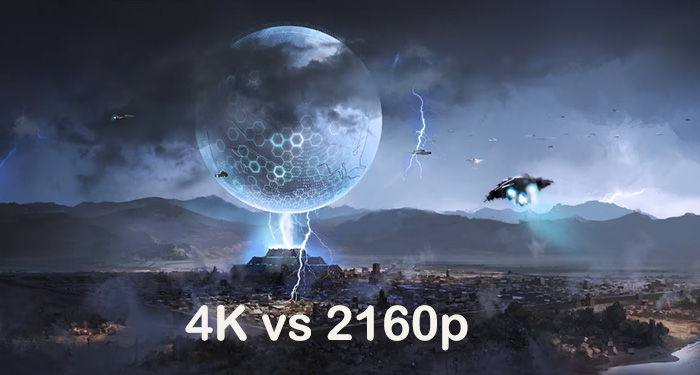4K UHD has a bright feature thanks to improved 4K content availability. When you are shopping for a 4K TV, you may have noticed that 4K TVs have various labels, namely 4K UHD TV, 2160p 4K Ultra HD TV, Ultra HD TV, but you can rarely see 2160p TV with the 4K term missing. Is 4K Ultra HD better than 2160p? Is 4K and 2160 the same? Why do we call the resolution 4K not 2160p? Here's what you want to know.
Best Free 4K UHD 2160p Video/Movie Downloader & Player
5KPlayer - 100% free 4K video player & downloader simply plays & downloads 4K 2160p videos movies as well as MKV MP4 FLV AVI MOV HEVC, VP9, H.264, DVD video/movie on your Windows and Mac computer smoothly without stuttering!
What Is 4K? What does 2160p Mean?
4K commonly refers to a resolution of 3,840x1,2160 pixels. We've posted "what is 4K UHD", so we are not going to dig deeper into the 4K definition here. To get better understanding of 4K UHD, read 4K vs 1080p, 4K vs 8K vs 10K.
2160p (also 3,840 × 2,160 pixels) is a resolution of 3840 vertical lines 2160 horizontal lines. The p stands for progressive scan or non-interlaced. 2160p vs 1080p, 2160p is four times the resolution of 1080p (also four times the file size of 1080p). 2160p is an alternative name for 4K or 4K UHD but is less used by the multimedia industry. It sounds that 4K is quite the same as 2160p, why is it 4K not 2160p?

Why do we call it 4K instead of 2160p?
The reason why the resolution is called 4K not 2160p is that it's the name of the Digital Cinema Initiatives (DCI) format. The name comes from the horizontal resolution - 4096 × 2160 pixels, nearly 4,000 pixels, and it's four times the resolution of 1080p. 4K definition and 4K resolution standard (4096 × 2160) determined by DCI is widely accepted by movie and video production industry, digital devices like 4K UHD TVs, cameras, iPhone. 4K is also known as 2160p and 4K Ultra HD (4K UHD). In fact, 4K is different from UHD.
"4K" originated from the digital cinema industry, where resolutions were standardized based on the width of the image in pixels. The term "4K" has been widely adopted and recognized around the world. It has become the de facto term for the UHD resolution in consumer electronics and the film industry.
4K vs 2160p, What's the Difference?
Is 4K and 2160p the same? 2160p is an alternative name for 4K UHD, but 2160p doesn't equal 4K. Besides 2160p (3,840x1,2160 px), there are several other 4K resolution standards there. Common 4K resolutions include UHD-1, UW4K, UHD-1, and DCI 4K.
UW4K (3840x1600 px) in 12:5 aspect ratio is commonly adopted by Ultra HD Blu-ray discs.
UHD-1 (also 2160p) has a resolution of 3840×2160 px (16:9, or approximately a 1.78:1 aspect ratio), which is a 4K standard used by TVs and computer monitors, games, game consoles, phones and video streaming. It is twice the horizontal and twice the vertical resolution of 1080p.
DCI 4K (Cinema 4K) has a resolution of 4096 × 2160 pixels (256:135, about 1.9:1 aspect ratio). It is popular among DCI 4K digital projectors and displays. So, is 4K better than 2160p? No. A true 4K display should have a resolution of 4096 × 2160, but most of them in the market are lower than this standard and even lower than 3820×2160, we sometimes call it 2160p.
Other 4K specifications mentioned on some sites like 5,120×2,880, 7680×4320 (UHD-2) are not truly 4K resolution. 5,120×2,880 and 7680×4320 (UHD-2) refer to 5K and 8K respectively. Currently, there's a limited resource in 5K or 8K FHD.
Misunderstandings about 4K and 2160p
1. 4K is 2160p and 2160p is 4K
2160p is a less-used alternative name for 4K, but it's not correct to say 2160p and 4K are the same. 4K has more than one resolution standard, as mentioned above. 2160p (UHD-1) is one of the 4K resolution specifications. "4K" refers to a horizontal resolution of approximately 4,000 pixels, while "2160p" refers to a vertical resolution of 2160 pixels. The most common 4K resolution is 3840 pixels × 2160 pixels, which is often referred to as "Ultra HD" or "UHD." However, in some contexts, "4K" might also refer to a slightly higher resolution of 4096 pixels × 2160 pixels, which is often used in digital cinema.
2. 4K UHD 2160p is HDR
4K refers to resolution, while HDR (high dynamic range) is a kind of tech used to offer wider color gamut. HDR allows for a wider range of colors and luminosity, resulting in more realistic and vibrant visuals. While it's possible to have a 4K UHD video at 2160p resolution with HDR, the two terms are not inherently tied together. You can have a 4K UHD video without HDR, and you can also have HDR content at resolutions other than 4K UHD.
3. 4K 2160p is UHD
Yes. Roughly speaking, 4K 2160p and UHD are the same. In terms of TVs, UHD (Ultra-High Definition) is developed using the same res of 4K and aspect ratio of 16:9. UHD includes 4K UHD and 8K UHD. The most common 4K resolution is 3840 pixels × 2160 pixels, which is often referred to as "4K UHD" or simply "UHD."
4. What Do I Need for 4K Ultra HD 2160p?
A 4K compatible TV that has HDMI 2.0 inputs and 4K supported receiver. The price tag of 4K TV is much lower than before, and you have plenty of choices from Samsung, LG, Sony, TCL etc. Most of 4K TVs come with the resolution of 3840×2160 pixels (UHD-1), also 2160p.
True 4K content. You should have video resources in true 4K Ultra HD, be it 4096 × 2160, 3820×2160, or 3840x1600. Otherwise, it's 4K upconverting.
A stable internet connection speed of 25Mbps is required for smooth 4K UHD video streaming.
4K Ultra HD video processing software may be needed to help download 4K UHD content for offline playback, convert 4K video formats, compress/edit 2160p Ultra HD videos, and upscale 1080p to 4K UHD and downscale 4K to 1080p, 720p for non-4K devices.








